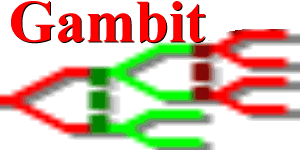Sample games¶
2x2x2.nfg- A three-player normal form game with two strategies per player. This game has nine Nash equilibria, which is the maximal number of regular Nash equilibria possible for a game of this size. See McKelvey, Richard D. and McLennan, Andrew (1997). The maximal number of regular totally mixed Nash equilibria. Journal of Economic Theory 72(2): 411-425.
2x2x2-nau.nfg- A three-player normal form game with two strategies per player. This game has three pure strategy equilibria, two equilibria which are incompletely mixed, and a continuum of completely mixed equilibria. This game appears as an example in Nau, Robert, Gomez Canovas, Sabrina, and Hansen, Pierre (2004). On the geometry of Nash equilibria and correlated equilibria. International Journal of Game Theory 32(4): 443-453.
bagwell.efg- Stackelberg leader game with imperfectly observed commitment, from Bagwell, Kyle (1993) Commitment and observability in games. Games and Economic Behavior 8: 271-280.
bayes2a.efg- A twice-repeated Bayesian game, with two players, each having two types and two actions. This game also illustrates the use of payoffs at nonterminal nodes in Gambit, which can substantially simplify the representation of multi-stage games such as this.
cent3.efg- A three-stage centipede game, featuring an exogenous probability that one player is an altruistic type, who always passes. See, for example, McKelvey, Richard D. and Palfrey, Thomas R. (1992) An experimental study of the centipede game. Econometrica 60(4): 803-836.
condjury.efg- A three-person Condorcet jury game, after the analysis of Feddersen, Timothy and Pesendorfer, Wolfgang (1998) Convicting the innocent: The inferiority of unanimous jury verdicts under strategic voting. American Political Science Review 92(1): 23-35..
loopback.nfg- A game due to McKelvey which illustrates that the logit quantal response equilibrium correspondence can have a “backward-bending” segment on the principal branch.
montyhal.efg- The famous Monty Hall problem: if Monty offers to let you switch doors, should you?
nim.efg- The classic game of Nim, which is a useful example of the value of backward induction. This version starts with five stones. An interesting experimental study of this class of games is McKinney, C. Nicholas and Van Huyck, John B. (2013) Eureka learning: Heuristics and response time in perfect information games. Games and Economic Behavior 79: 223-232.
pbride.efg- A signaling game from Joel Watson’s Strategy textbook, modeling the confrontation in The Princess Bride between Humperdinck and Roberts in the bedchamber.
poker.efg- A simple game of one-card poker introduced in Myerson, Roger (1991) Game Theory: Analysis of Conflict.. A bit unusually for poker, the “fold” action by a player with a strong hand counts for a win for that player, so folding is only weakly rather than strictly dominated in this case.
4cards.efg- A slightly more complex poker example, contributed by Alix Martin.
spence.efg- A version of Spence’s classic job-market signaling game. This version comes from Joel Watson’s Strategy textbook.
These games, and others, ship in the standard Gambit source distribution in the directory contrib/games.
